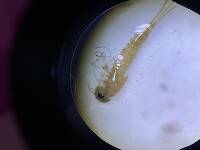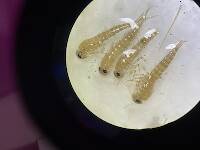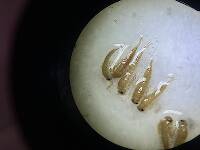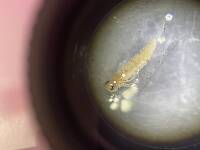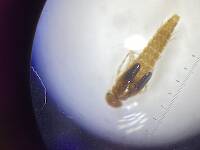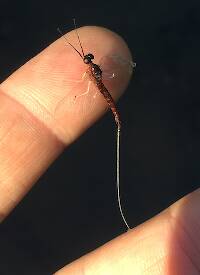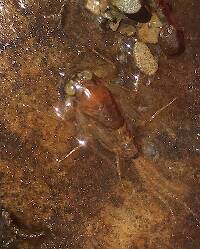
Salmonflies
Pteronarcys californica
The giant Salmonflies of the Western mountains are legendary for their proclivity to elicit consistent dry-fly action and ferocious strikes.
Featured on the forum

This is an interesting one. Following the keys in Merritt R.W., Cummins, K.W., and Berg, M.B. (2019) and Jacobus et al. (2014), it keys clearly to Ephemerella. Jacobus et al provide a key to species, but some of the characteristics are tricky to interpret without illustrations. If I didn't make any mistakes, this one keys to Ephemerella mucronata, which has not previously been reported any closer to here than Montana and Alberta. The main character seems to fit well: "Abdominal terga with prominent, paired, subparallel, spiculate ridges." Several illustrations or descriptions of this holarctic species from the US and Europe seem to match, including the body length, tarsal claws and denticles, labial palp, and gill shapes. These sources include including Richard Allen's original description of this species in North America under the now-defunct name E. moffatae in Allen RK (1977) and the figures in this description of the species in Italy.

Troutnut is a project started in 2003 by salmonid ecologist Jason "Troutnut" Neuswanger to help anglers and
fly tyers unabashedly embrace the entomological side of the sport. Learn more about Troutnut or
support the project for an enhanced experience here.
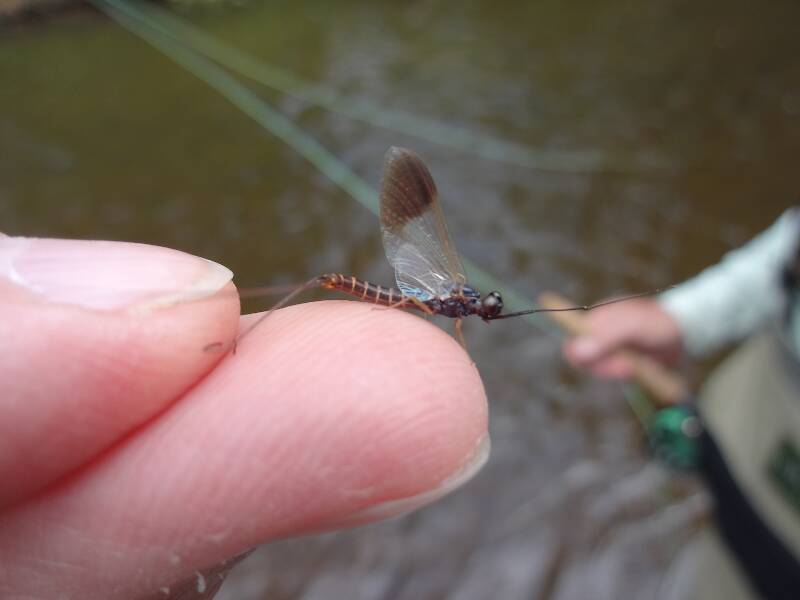
Levwood on Jun 10, 2013June 10th, 2013, 3:16 pm EDT
Mayfly captured in the Black River, northern Michigan on June 7. Can anyone tell me the name of this bug? Thanks, Lev
levwood@earthlink.net
levwood@earthlink.net
Lev
Oldredbarn on Jun 10, 2013June 10th, 2013, 6:02 pm EDT
Looks to me like a Leptophlebia...cupida or nebulosa...Though I've never seen the odd dark markings on the wing?
We call it the Borcher's Drake...Thought to be the model for Ernie Borcher's famous Au Sable fly.
We call it the Borcher's Drake...Thought to be the model for Ernie Borcher's famous Au Sable fly.
"Even when my best efforts fail it's a satisfying challenge, and that, after all, is the essence of fly fishing." -Chauncy Lively
"Envy not the man who lives beside the river, but the man the river flows through." Joseph T Heywood
"Envy not the man who lives beside the river, but the man the river flows through." Joseph T Heywood
Entoman on Jun 10, 2013June 10th, 2013, 6:16 pm EDT
It looks like a male Isonychia tusculanensis imago, but they're not supposed to be in N. MI. Leptophlebia nebulosa looks very similar and does have the brown tipped wings as well. They have a terminal filament that I'm not seeing though. Even so, nebulosa is found in MI, so that would be my guess. Perhaps the middle tail was knocked off as these guys are always losing tails.
"It's not that I find fishing so important, it's just that I find all other endeavors of Man equally unimportant... And not nearly as much fun!" Robert Traver, Anatomy of a Fisherman
Levwood on Jun 11, 2013June 11th, 2013, 3:53 pm EDT
Gentlemen, you guys are great. I do not have other photos, just this one. One of the tails did break off in my fingers. I'll go with the Leptophlebia since the folks at Gates Lodge did mention this off the cuff. If anyone else has a guess please weigh in but I think this case is solved! Thanks.
Lev
Lev
Lev
Entoman on Jun 12, 2013June 12th, 2013, 9:59 am EDT
One of the tails did break off in my fingers.
Nebulosa it is then, Lev.
The brown spot is likely from too much finger pressure on the wings with the hands. That often breaks the veins and lets the fluid out into the wings membrane.
Huh? Were'd you get this from, Mack...:)
"It's not that I find fishing so important, it's just that I find all other endeavors of Man equally unimportant... And not nearly as much fun!" Robert Traver, Anatomy of a Fisherman
Crepuscular on Jun 12, 2013June 12th, 2013, 11:28 am EDT
The brown spot is likely from too much finger pressure on the wings with the hands. That often breaks the veins and lets the fluid out into the wings membrane.
What?
Taxon on Jun 12, 2013June 12th, 2013, 1:06 pm EDT
Hi Mack,
I too have observed a yellow liquid-appearing spot, usually in the tip of one fore wing, and have often wondered about it, although it never occurred to me that it might be the result of a mayfly having been captured by its wing tips.
However, in the case of Leptophlebia nebulosa , the brown staining on the outer 2/5 of their fore wings serve to distinguish them from other Leptophlebia species.
I too have observed a yellow liquid-appearing spot, usually in the tip of one fore wing, and have often wondered about it, although it never occurred to me that it might be the result of a mayfly having been captured by its wing tips.
However, in the case of Leptophlebia nebulosa , the brown staining on the outer 2/5 of their fore wings serve to distinguish them from other Leptophlebia species.
Levwood on Jun 13, 2013June 13th, 2013, 9:38 am EDT
You guys are awesome. I have a great shot of a large black Michigan stonefly you can take a shot at too. Want it?
Lev
Lev
Lev
Quick Reply
Related Discussions
Topic
Replies
Last Reply
6
Aug 21, 2010
by Gutcutter
by Gutcutter
2
Jul 9, 2018
by Martinlf
by Martinlf
3
Jun 27, 2018
by Konchu
by Konchu
5
Aug 12, 2007
by Wbranch
by Wbranch
11
Feb 26, 2008
by Taxon
by Taxon






